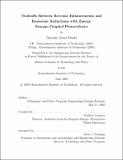Tradeoffs between revenue enhancements and emissions reductions with energy storage-coupled photovoltaics
Author(s)
Heidel, Timothy David
DownloadFull printable version (3.176Mb)
Other Contributors
Massachusetts Institute of Technology. Technology and Policy Program.
Advisor
Stephen Connors.
Terms of use
Metadata
Show full item recordAbstract
Energy storage has the potential to dramatically change the operation of photovoltaics by allowing for a delay between generation and use. This flexibility has the potential to impact both the revenue from generating electricity using photovoltaics and the associated emissions reductions. This thesis attempts to quantify the impacts of adding energy storage to photovoltaics. The thesis formulates an optimization problem to solve for the optimal use of photovoltaics with energy storage from 2000 to 2005 in New England. The optimization is first solved using perfect information about historical solar generation, energy prices, and marginal emissions rates. Then, the model is solved using forecasted energy prices and emissions rates. The analysis finds that adding energy storage to photovoltaics can increase annual revenues by over 30%. With energy storage capacity and power equal to solar capacity, annual revenues were found to increase between 19.3% and 31.1% with an energy storage efficiency of 100%. Unfortuneately, the potential revenue increases were found to fall to between 9.1% and 21.3% with 80% efficient storage and between 3% and 14.5% with 60% efficient storage. However, when owners utilize energy storage to maximize revenue, the changes in avoided emissions with energy storage are found to be negligible. Alternatively, it is possible to achieve significant increases in the emissions offset by photovoltaics with energy storage. However, when energy storage is utilized to maximize emissions reductions, revenue decreases. (cont.) This tradeoff between the economic and environmental benefits that can be achieved when energy storage is added to photovoltaics means it is unlikely to be possible, without policy, to simultaneously achieve large increases in both revenue and avoided emissions. Policy mechanisms could be used to enable energy storage to enhance both the revenue from photovoltaics and avoided emissions.
Description
Thesis (S.M. in Technology and Policy)--Massachusetts Institute of Technology, Engineering Systems Division, Technology and Policy Program, 2009. This electronic version was submitted by the student author. The certified thesis is available in the Institute Archives and Special Collections. Includes bibliographical references (p. 111-114).
Date issued
2009Department
Massachusetts Institute of Technology. Engineering Systems Division; Technology and Policy ProgramPublisher
Massachusetts Institute of Technology
Keywords
Engineering Systems Division., Technology and Policy Program.